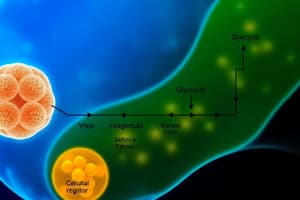Podcast
Questions and Answers
What is the main output of glycolysis?
What is the main output of glycolysis?
- Fructose
- Lactate
- Glucose
- Pyruvate (correct)
What happens during the Energy Investment Phase of glycolysis?
What happens during the Energy Investment Phase of glycolysis?
- Production of ATP
- Consumption of ATP (correct)
- Oxidation of glucose
- Conversion of pyruvate to glucose
Which enzyme is NOT involved in the Energy Payoff Phase of glycolysis?
Which enzyme is NOT involved in the Energy Payoff Phase of glycolysis?
- Hexokinase (correct)
- Phosphoglycerate kinase
- Glyceraldehyde-3-phosphate dehydrogenase
- Pyruvate kinase
How many NADH molecules are produced during glycolysis?
How many NADH molecules are produced during glycolysis?
What inhibits phosphofructokinase in glycolysis?
What inhibits phosphofructokinase in glycolysis?
What is the net gain of ATP from glycolysis?
What is the net gain of ATP from glycolysis?
In anaerobic conditions, pyruvate can be converted into which compound in animals?
In anaerobic conditions, pyruvate can be converted into which compound in animals?
Which statement about glycolysis is correct?
Which statement about glycolysis is correct?
Flashcards are hidden until you start studying
Study Notes
Overview of Glycolysis
- Glycolysis is a metabolic pathway that converts glucose into pyruvate.
- It occurs in the cytoplasm of cells.
- It is the first step in cellular respiration and occurs in both aerobic and anaerobic conditions.
Key Stages of Glycolysis
-
Energy Investment Phase
- Consumes 2 ATP to phosphorylate glucose and intermediates.
- Key enzymes:
- Hexokinase (glucose to glucose-6-phosphate)
- Phosphofructokinase (fructose-6-phosphate to fructose-1,6-bisphosphate)
-
Cleavage Phase
- The six-carbon sugar (fructose-1,6-bisphosphate) splits into two three-carbon molecules (glyceraldehyde-3-phosphate).
-
Energy Payoff Phase
- Produces 4 ATP (net gain of 2 ATP) and 2 NADH molecules.
- Key reactions:
- Conversion of glyceraldehyde-3-phosphate to pyruvate.
- Enzymes involved:
- Glyceraldehyde-3-phosphate dehydrogenase (produces NADH)
- Phosphoglycerate kinase (produces ATP)
- Pyruvate kinase (produces ATP and pyruvate)
Key Products
- 2 Pyruvate molecules
- 2 ATP (net gain)
- 2 NADH molecules
- 2 H+ ions
Regulation of Glycolysis
- Allosteric Regulation:
- Phosphofructokinase is inhibited by high levels of ATP and stimulated by AMP.
- Hexokinase is inhibited by its product, glucose-6-phosphate.
Importance of Glycolysis
- Provides energy quickly in anaerobic conditions.
- Key link between carbohydrate metabolism and other metabolic pathways.
- Central to both aerobic and anaerobic respiration.
Anaerobic Fate of Pyruvate
- In the absence of oxygen, pyruvate can be converted to:
- Lactate (in animals, during lactic acid fermentation)
- Ethanol and carbon dioxide (in yeast, during alcoholic fermentation)
Summary
- Glycolysis is a crucial metabolic process for energy production.
- It involves a series of enzymatic reactions, resulting in the conversion of glucose to pyruvate, with a net gain of ATP and NADH.
- Understanding glycolysis is essential for comprehending broader metabolic pathways and energy production mechanisms.
Overview of Glycolysis
- Glycolysis transforms glucose into pyruvate, occurring in the cytoplasm.
- Functions as the initial step in cellular respiration under both aerobic and anaerobic conditions.
Key Stages of Glycolysis
-
Energy Investment Phase
- Utilizes 2 ATP to phosphorylate glucose and its intermediates.
- Major enzymes include:
- Hexokinase: converts glucose to glucose-6-phosphate.
- Phosphofructokinase: converts fructose-6-phosphate to fructose-1,6-bisphosphate.
-
Cleavage Phase
- Fructose-1,6-bisphosphate splits into two molecules of glyceraldehyde-3-phosphate.
-
Energy Payoff Phase
- Yields 4 ATP (with a net gain of 2 ATP) and 2 NADH.
- Key reactions involve:
- Conversion of glyceraldehyde-3-phosphate to pyruvate.
- Important enzymes:
- Glyceraldehyde-3-phosphate dehydrogenase: produces NADH.
- Phosphoglycerate kinase: generates ATP.
- Pyruvate kinase: finalizes production of ATP and pyruvate.
Key Products
- Produces 2 pyruvate molecules.
- Generates a net gain of 2 ATP and 2 NADH molecules.
- Releases 2 H+ ions.
Regulation of Glycolysis
- Allosteric Regulation:
- Phosphofructokinase is inhibited by high ATP levels and activated by AMP.
- Hexokinase activity is reduced by its product, glucose-6-phosphate.
Importance of Glycolysis
- Delivers rapid energy supply in anaerobic conditions.
- Acts as a critical junction in carbohydrate metabolism.
- Vital for both aerobic and anaerobic respiration.
Anaerobic Fate of Pyruvate
- In the absence of oxygen, pyruvate can be converted into:
- Lactate in animals (associated with lactic acid fermentation).
- Ethanol and carbon dioxide in yeast (during alcoholic fermentation).
Summary
- Glycolysis is essential for energy production, converting glucose to pyruvate with a net yield of ATP and NADH.
- Comprehending glycolysis is fundamental for insights into broader metabolic pathways and energy mechanisms.
Studying That Suits You
Use AI to generate personalized quizzes and flashcards to suit your learning preferences.




